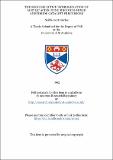The regioselective hydrogenation of acrylic acids using rhodium-mixed anhydride catalyst precursors
Abstract
Complexes of general composition [RhCl(PPh₃)n(Ph₂P0₂CCR = CR'R'')] (n=2 R = H, R' =R" =Me; R = R' =H, R'' =CH = CHMe; R = Me, R' =H, R'' =Ph; n=l, R = R'=H, R'' =Me or CH = CHMe) have been used as precursors for the catalytic hydrogenation of various substituted acrylic acids, [HO₂CCR = CR' R'']. The reactions of [RhCl(PPh₃)(Ph₂P0₂CCH = CHMe)] and '[0₂CCH = CHMe] and [RhCl(PPh₃)₂(Ph₂P0₂CCMe = CHPh)] and '[0₂CCIVIe = CHPh] give [Rh(0₂CCH = CHMe)(PPh₃)(Ph₂P0₂CCH = CHMe)] and [Rh(0₂CCMe = CHPh)(PPh₂)(Ph₂P0₂CCMe = CHPh)] accordingly and these complexes are the respective active species in the catalytic hydrogenation of but-₂- enoic acid and ₂-methyl-₃-phenylpropenoic acid. The crossed reactions between [RhCl(PPh₃)(Ph₂P0₂CCH = CHMe)] and [0₂CCMe = CHPh], [RhCl(PPh₃)₂(Ph₂P0₂CCMe = CHPh)] and [0₂CCH = CHMe], [RhCl(PPh₃)(Ph₂P0₂CCH = CHMe)] and '[09CCH = CMe₂] and [RhCl(PPh₃)₂(Ph₂P0₂CCH = CMe₂)] and '[0₂CCH = CHMe] predominantly yield products in which the chelate mixed anhydride ligand is but-2-enoic acid derived, on account of its lesser substituted carbon-carbon double bond. Attempts at isolating hydride intermediates in the catalytic cycle have proved unsuccessful. However, investigations of the step by which the product carboxylic acid anion is released from the metal complex (transesterification reaction) have involved the synthesis of [RhCl(PPh₂)₂(Ph₂P07CCH₂CH₂Me)] (₂ isomers) from [RhCl(PPh₃)₃] and [Ph₂PO₂CCH₂CH₂Me] and [Rh(PPh₃)₂(Ph₂P0₂CCH₂CH₂Me)]+ from [RhCl(PPh₃)₂(Ph₂P0₂CCH₂CH₂Me)] and TlPFg. The reactions of both these products with '[0₂CCH = CHMe] yield the active species [Rh(0₂CCH = CHMe)(PPh₃)(Ph₂P0₂CCH = CHMe)]. Prior to transesterification the most likely intermediate in the catalytic cycle is [Rh(0₂CCH₂CH₂Me)(PPh₃)n(Ph₂P0₂CCH₂CH₂Me)] (n = l or ₂) in which both the mixed anhydride and the coordinated anion have been hydrogenated. The reaction of [RhCl(PPh₃)₂(Ph₂P0₂CCH₂CH9CH₃)] with K[0₂CCH₂CH₂CH₃)] affords the fluxional, square-planar species, [Rh(0₂CCH₂CH₂CH₃)(PPh₃)₂(Ph₂P0₂CCH₂CH₂CH₃)]. The hydrogenation of hexa-4-dienoic acid, [H0₂CCH = CHCH = CHMe], using rhodium-mixed anhydride complexes yields both hexanoic and hex-₄-enoic acids via two concurrent mechanisms, since the active species, [Rh(0₂CCH = CHCH = CHMe)(PPh₃)(Ph₂P0₂CCH = CHCH = CHMe)] exists in two forms; one containing a chelate mixed anhydride, the other a chelate hexa-4- dieonate ligand. The production of hexanoic acid is brought about by the active involvement of the chelate hexa-4-dienoate ligand in the catalytic cycle. Attempts to prevent this involvement have centred around the replacement of the chloride ligand in the catalyst precursor with non-labile fluoride and trifluoromethyl anions. [RhF(PPh₂)₃l reacts with mixed anhydride ligands to give ₅-coordinate species, [RhF(PPh₂)₂(Ph₂P0₂CCR = CR' R' ' )], in which the mixed anhydride is bound via phosphorus and carbonyl oxygen, however these precursors show no increased regioselectivity. The reaction of [RhCl(PPh₃)₂] with [Hg(CF₃)₂] does not yield [RhCF₂(PPh₂)₃] but [RhCl(PF₂)(PPh₃)₂], and in the presence of excess PPh₃ yields [RhCl(CF₃)₂(PPh₃)₂]. Other attempts to prevent the involvement of the bidentate hexa-4-dienoate ligand in the catalytic cycle have involved the addition of PPh₃ or CH₃CO₂H to the catalytic solution, and to a certain degree increased regioselectivity towards the production of hex-₄-enoic acid has been achieved. NOTE: All ³¹P NMR spectra presented, have their chemical shifts quoted relative to H₃PO₄, whilst all ¹⁹F NMR shifts are relative to CCI₃F.
Type
Thesis, PhD Doctor of Philosophy
Collections
Items in the St Andrews Research Repository are protected by copyright, with all rights reserved, unless otherwise indicated.

